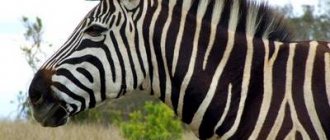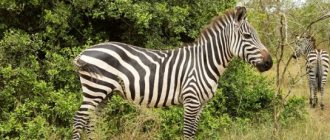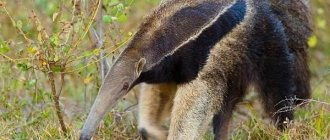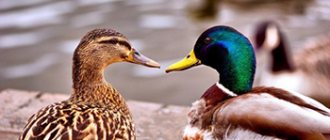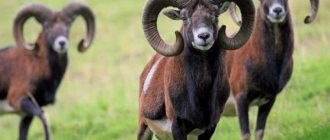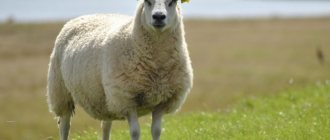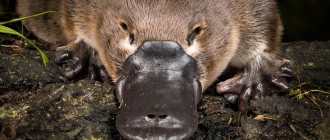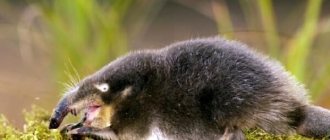| Class : Mammals | Family : Equines | Order : Perissodactyls |
| Genus : Horses | Subgenus : Zebras | |
Zebras are amazing inhabitants of hot Africa, one of the symbols of its wild nature.
Thanks to their strange color, they cannot be confused with anyone else. The animals are close relatives of horses, and the first documentary mentions of them date back to Ancient Rome, where strange striped horses were shown in circuses and zoos. From this article you can find out: how long zebras live, what they eat, how they reproduce, how they build relationships with other animals and humans. Detailed information about the striped horse, a selection of interesting facts, and a lot of colorful photographs are presented. The information will help the child prepare an interesting message and write an essay.
Description and features
The animal combines the characteristics of a donkey and a horse. Zebra is a small animal, body length is about 2 m, weight up to 360 kg. Males are larger than mares, their maximum height is 1.6 m.
The elastic physique, high ears, and relatively long tail reflect the characteristic features of an ordinary donkey. The zebra has a mane of short hair of a rigid structure located vertically. A woolen brush adorns the head and stretches along the back to the tail.
The legs are low, dense, strengthened by strong hooves. The animals gallop rapidly, up to 75 km/h, although they are inferior to horses in speed. Running tactics with sharp turns and weaving movements help to avoid pursuit. Zebras are superior to large predators in fighting due to their physical strength and endurance.
The zebra in the photo has expressive eyes, but its vision is weak, although the animal, like a human, can distinguish colors. An excellent sense of smell allows them to navigate; thanks to it, animals sense danger at a considerable distance from the predator.
Guard zebras notify all families by shouting about the threat of attack. The sounds produced by animals are very different - the voice of a zebra at different moments resembles the neighing of horses, the barking of domestic dogs, the cries of a donkey.
Listen to the zebra's voice
A zebra is a striped animal, a contrasting pattern on its fur is the calling card of an individual. The individual color graphics of the animal are manifested in the alternation of stripes, different in width, length, and direction. The vertical arrangement of lines is typical for the head and neck, a sloping pattern is on the torso, and horizontal stripes are on the legs.
The color is associated with the habitat of the families:
- individuals with a black and white pattern are characteristic of the lowland areas of northern Africa;
- zebras with black and gray stripes and a brown tint of fur - for the savannahs of South Africa.
Animals recognize each other perfectly, and foals accurately identify their mother. The debate about what the base color is has been going on for a long time. More often in the description of a zebra there is the definition of a black horse with the presence of white stripes, which is confirmed by the study of embryos. The black color is provided by pigmentation; in its absence, white fur is formed.
Some scientists believe that in evolutionary development, natural color arose as a means of protection from numerous horseflies and other insects, whose compound eyes see contrasting stripes differently and perceive them as an inedible object.
Another hypothesis of scientists connects the contrasting color with protection from predators, for whom the ripples of the stripes prevent them from identifying potential prey in the trembling air of the savannah. The third point of view explains the presence of stripes by the special thermoregulation of the body - the stripes heat up to varying degrees, thereby ensuring air movement in the immediate vicinity. This is how zebras manage to survive under the hot sun.
Enemies in the wild
The main dangerous enemy of the zebra is the African lion, which loves the meat of this animal and considers it a delicacy. Most often, the predator lies in wait for its prey on the way to a watering hole or looks for young individuals that have strayed from the herd.
A zebra can also become a victim:
- cheetah;
- leopard;
- hyenas;
- person.
In times of danger, a relative of the horse can reach speeds of up to 70 km/h, which does not always allow predators to feast on their tasty meat. The zebra can run very deftly in zigzags, confusing even very experienced hunters.
The zebra defends itself with powerful hooves, which it uses to hit the enemy with all its strength; sometimes such a blow can be fatal. The animal also bites very painfully.
Man can be considered the most terrible enemy for the animal, since many zebra breeds disappeared precisely because of his fault.
Kinds
In the classification of zebras, there are 3 varieties:
Savannah zebra. There is a second name - Burchellovaya, since for the first time the striped inhabitants of Africa were studied and described by zoologist V. Burchell. Compared to other species, this species is numerous and distributed throughout southeast Africa.
A medium-sized animal, approximately 2.4 meters in length, weighing up to 340 kg. The intensity of the color and the clarity of the coat pattern depend on the area of residence, as a result of which 6 subspecies of savannah zebra have been identified. A description of the quagga zebra species, which became extinct in the second half of the 19th century, has been preserved.
The appearance of the animal was dual - the bay color of the horse on the back of the body, the striped pattern on the front. Tamed animals guarded herds for a long time. Family groups in savannas consist of approximately 10 individuals. During particularly dry periods, animals move closer to the foothills in search of lush greenery.
Desert zebra. The additional name, Grevy's zebra, appeared after the leadership of Abyssinia presented the President of France with a striped desert inhabitant. Animals are successfully preserved in the territories of national parks in East Africa - Ethiopia, Kenya, Uganda, Somalia.
The desert inhabitant is larger than other types of zebras - the length of an individual is 3 m, weight is approximately 400 kg. An important difference is observed in the predominantly white coat color and the presence of a black stripe along the ridge. The zebra's belly is light, without stripes. The frequency of the bands is higher - they are spaced more closely. The ears are brownish in color and round in shape.
Mountain zebra. The classification includes two varieties - Cape and Hartmann. Both species, despite the protective measures taken by zoologists, are under threat of complete extinction due to the fault of local farmers-poachers who shoot the original inhabitants of southwest Africa. The Cape zebra is small in shape and has no pattern on its belly.
Hartmann's zebra has particularly long ears.
A special place is occupied by hybrids that appeared as a result of crossing a zebra with a domestic horse, or a zebra with a donkey. The male is the zebra, from which the striped color is inherited. An important quality of hybrid individuals is their flexibility in training compared to a wild zebra.
Zebroids resemble horses, partially colored with paternal stripes. Zebrulla (osozebra) is an animal similar to a zebra only in the presence of stripes on certain parts of the body. Hybrids have a very aggressive character that can be adjusted. Animals are used as pack transport.
Lifestyle and habitat
Zebra is a wild animal of the African continent. In the north, the wild inhabitants of the green plains were exterminated in ancient times. Populations of desert and savannah zebra species persist in the eastern part of the continent in the steppe zones to the southern regions of the continent. Small numbers of mountain zebras live in high mountain areas.
Animal social connections are reflected in different ways. Animals sometimes gather in small herds of separate groups of 10 to 50 individuals. In the zebra family (male, 5-6 mares, foals) there is a strict hierarchy, the cubs are always under the fierce protection of adults.
Family groups can live separately, outside the herd. Among lowland animals there are associations of young males who have not yet acquired their own harems. They are expelled from the herd to live independently upon reaching 3 years of age. Lonely individuals who do not join their relatives often become victims of hyenas, leopards, lions, and tigers.
A peculiarity of zebra behavior is the ability to sleep standing up, huddled in a group for protection from predators. Several sentinels guard the peace of the family. If necessary, they give desperate resistance to enemies. The zebra's irreconcilable temperament at the moment of fight and endurance do not allow even a lion to cope with it.
When an enemy appears, the animals make barking sounds. Natural caution and timidity leaves little chance for predators to cope with a zebra. The prey is exclusively weakened individuals, physically fragile foals separated from the herd.
Zebra in the savannah unites well in herds with other inhabitants of Africa - gazelles, buffaloes, wildebeests, ostriches, giraffes, in order to together resist attacks from predators.
Attacks on striped horses most often occur during watering. The animal defends itself by actively kicking - a blow with a hoof can be fatal to the enemy. Zebra bites are very painful. When an animal rears up, its size visually increases, which has a terrifying effect on the enemy.
In observations of zebra behavior, scientists note in everyday life the animal’s predilection for bathing in mud in order to get rid of parasites. The bull woodpecker helps zebras to be clean, as it easily sits on the animal’s skin and picks out all the insects from the fur. The zebra, despite the bird's blows with its beak, does not drive away its orderly.
The mood of tamed animals is determined by ear movements:
- in the normal state - located straight;
- in aggressive – tilted back;
- in a moment of fright, they move forward.
Animals show dissatisfaction by snorting. Even domesticated individuals retain manifestations of their wild relatives.
What order do zebras belong to?
Zoology classifies the zebra as a member of the equine family of the equidae order. In its modern form, the animal appeared on the planet about 4.5 million years ago. It had a common ancestor with the donkey and the horse.
The common genome allows these species to have viable offspring. Crossing a zebra and a horse produces zebroids. A donkey and a zebra will give birth to zebras. But within its own subgenus everything is much more complicated. Attempts to cross different species of animals with each other almost always end in miscarriage.
Are they horses or not?
Like all equines, zebras live in herds - large family groups.
The composition and number of groups differ in different animal species. Thus, savanna and mountain varieties form groups consisting of 4-8 females with cubs. At the head of the harem is a stallion. He is responsible for protecting the team and initiates migration processes. Among females, dominance belongs to the oldest and most experienced individual.
Young males, upon reaching a certain age, leave their native herd. They unite in bachelor groups, or live alone, dreaming of creating their own harem.
The desert species does not have such strong attachments. Groups in striped animals are created spontaneously, for only a few months a year. Only mothers and their babies are inseparable.
Nutrition
Herbivores require a significant amount of food to saturate the body with the required number of calories. The food is succulent grass cover, plant rhizomes, leaves, buds on bushes, tree bark, and any young shoots. Animals are constantly engaged in obtaining food. During the dry season, herds head out in search of pastures.
Animals have a vital need for water and need it at least once a day. Water is especially important for lactating females. In search of sources for watering, herds travel considerable distances. If rivers dry up due to the heat, zebras look for underground channels - they dig real wells, up to half a meter deep, and wait for the water to drain.
The feeding habits of various mammal species depend on the region where they live. Thus, the diet of desert zebras is dominated by roughage food with a fibrous structure, bark, and foliage. Mountain individuals feast on the soft, lush grass covering the green slopes. Zebras do not refuse juicy fruits, buds, and tender shoots.
In addition to natural grazing, tamed individuals are fed with mineral supplements and vitamins, which increases physical endurance and affects longevity.
What is the name of a baby pigeon?
No matter how trivial and simple it may sound, pigeon chicks are called just that - pigeon chick. In colloquial speech they use “little dove” in the singular and “little doves” in the plural.
Interesting materials:
What does the word khinkali mean? What does the word Khobalka mean? What does the word Howe mean in rap? What does the word classification mean? What does the word maple as a tattoo mean? What does the word consistency mean? What does the word ending mean? What does the word goat mean? What does the word crown mean? What does the word Xerite mean?
Reproduction and lifespan
The offspring becomes sexually mature at 2.5-3 years of age. Female zebras are ready to mate earlier, males later. Reproduction occurs every three years, although the observational history includes examples of annual litters. Females give birth to offspring throughout 15-18 years of their lives.
The duration of a female's pregnancy is 370 days. Most often, one foal is born, weighing approximately 30 kg. The newborn is reddish in color. From the first hours the cub shows independence - stands on its legs and sucks milk.
After a few weeks, the little zebra baby begins to nibble little by little on the young grass, but the mother’s nutrition is maintained throughout the year, as it protects the babies’ fragile bodies from infections and protects the reliable functioning of the intestines. Zebra milk is a rare pink color.
Foals are carefully protected by all adults in their families, but, nevertheless, the mortality rate of offspring from attacks by predators remains high. The life of a zebra in the natural environment lasts 30 years, unless it becomes prey to natural enemies.
In the protected conditions of national parks, domesticated zebras become record-breaking long-livers of 40 years. Zebra is an animal of Africa , but its value in the ecological system has no continental boundaries. The image of a striped inhabitant with a stubborn nature has entered into culture and history.
